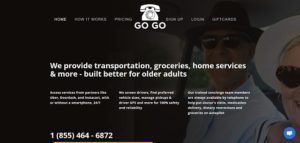Whether from a disability or a decline in physical and/or mental capabilities due to aging or chronic illness, there are many elderly and disabled adults who are unable to drive. That leaves them reliant on friends, family, and public or private transportation services to get from place to place.
Having access to reliable transportation is crucial for the health and well-being of the elderly and disabled. It’s easy to take advantage of the ability to hop in your car and drive to the pharmacy to pick up a prescription or stop by the grocery store to grab something for dinner. Without the convenience of being able to drive and having access to a vehicle, older adults and people with disabilities are at risk of social isolation, as they often spend more time at home alone because it’s difficult to get out and about. What’s more, not being able to pick up that prescription refill or get to the doctor may mean the person is going without crucial healthcare services and treatments, resulting in physical health consequences.
While safe and reliable transportation remains an important concern, the elderly and disabled have more transportation options to choose from today than ever before. In this post, we’ll take a look at the different types of transportation services that are available for the elderly and disabled and how to find out what services are available in your local area, including:
- Public Transportation
- Paratransit Services
- County Transportation Services
- Non-Profit and Faith-Based Transportation Services
- The Independent Transportation Network America (iTN America)
- Rides In Sight
- Veyo
- Ride-Sharing and On-Demand Transportation Services
Read on to learn more about each of these options and how to find out what transportation services are available in your area.
Public Transportation
Public transportation services can vary from location to location and can include several means of transportation such as trams, subway systems, light rails, buses, trolleys, and ferries. These services typically have accessibility features that make it easier for people with disabilities to utilize them, but riders are on their own when it comes to paying their fare, getting on at the right location and getting off at the right stop. Riders then need to find a way to travel from the stop to their destination, whether by foot or another means of transportation.
While larger cities and metropolitan areas typically have more public transportation services to choose from, the downside is that it can take much longer to get to your destination than it would by car due to the many stops these services make. In suburban and rural areas, public transportation can be more efficient compared to the big city, but there are often fewer transportation options, and they may serve limited areas. On the plus side, public transportation doesn’t usually cost a lot of money – at least not compared to private transportation services.
If you’re considering public transportation, here’s where to find more information.
The American Public Transit Association
The American Public Transit Association maintains a list of links to transit agencies serving cities, towns, and counties throughout the U.S. Start by clicking on your state for links to transit agencies by type of transportation and geographic area.
Paratransit Services
![]()
Public transportation services aren’t suitable for all older adults and people with disabilities, and that’s where paratransit services come in. For example, it may be too difficult for some older adults and people with disabilities to navigate stairs or walk from a stop to their destination and vice-versa.
The Americans with Disabilities Act (ADA) requires all public transportation agencies to provide paratransit services for people who are unable to use the primary transportation services. Paratransit services must cover approximately the same area as the public transportation service and typically use wheelchair-accessible vans instead of other forms of transportation.
Known as a curb-to-curb service, paratransit services can transport elderly and disabled people from place to place. They can help the rider get into and out of the vehicle; however, they are not able to assist riders in getting from their home to the vehicle or from the vehicle to the door at their destination.
In some cases, a non-disabled person (a personal care attendant) rides with the rider to help them get from the door to the vehicle and vice-versa. Medicaid may cover all or part of the cost for a Personal Care Attendant (PCA) for eligible older adults and people with disabilities.
The most important thing to note about paratransit services is that they’re not free. In fact, they may cost up to twice as much as an equivalent trip on the standard public transportation service. To take advantage of paratransit services, individuals must meet eligibility criteria and register with the paratransit service in advance. Rides must also be scheduled in advance – typically 24 hours or more – so these services aren’t ideal for the last-minute trip or emergency.
If you think paratransit services are a good option for yourself or your loved one, here’s where you can turn for more information.
Local Public Transit Agencies
You can find information about the paratransit services in your area through your local public transit agencies. Visit the American Public Transit Association’s directory of public transit resources to find your state and then visit your state’s public transit association website for more information.
National Aging and Disability Transportation Center
The National Aging and Disability Transportation Center is a Federal Transit Administration program that’s administered by Easterseals and USAging. It’s designed to put information and resources in a central, accessible location to make it easier for seniors, people with disabilities, loved ones, and caregivers to find safe and reliable transportation services.
Area Agency on Aging
Your local Area Agency on Aging (AAA) can also help you find information and connect you with these and other transportation resources. You can find your local AAA by searching the Eldercare Locator by city and state or zip code.
County Transportation Services

Many (but not all) areas offer county-based transportation services for the elderly. These services offer door-to-door service, and drivers may be able to assist older adults and people with disabilities in getting from their home to the vehicle and from the vehicle into the doors at their destination. County transportation services are often free or low-cost, but they’re not available in every county throughout the U.S. If there is a county transportation service in your area, there’s no guarantee that your destinations are within the covered service area.
You’ll need to sign up for the program in advance and schedule your rides a day or two ahead of when you need them, so like paratransit services, this isn’t the best choice for last-minute transportation needs. However, it’s a good way to ensure that you or your loved one has reliable transportation to doctor’s appointments and other locations that you can plan ahead for.
For more information on local county transportation services available in your area, here’s where to look for help.
Area Agency on Aging
Your local Area Agency on Aging is often the best source of information if you’d like to find out if your area offers a service and how it works. Find your local Area Agency on Aging using the Eldercare Locator.
Non-Profit and Faith-Based Transportation Services

Non-profit and faith-based organizations may offer transportation services for the elderly and disabled in your area. These programs are independent from state and local government services and typically rely on volunteers to provide free or low-cost transportation services to local seniors and people with disabilities.
The coverage areas provided by these programs vary greatly. Generally, they offer transportation for doctor’s appointments, shopping, recreational activities, and other needs within a specified service area at a low cost or, in some cases, free. Others may only provide transportation to doctor’s appointments. In nearly all cases, rides must be scheduled in advance to ensure the availability of a volunteer driver.
If you’re interested in learning about the non-profit and faith-based transportation services in your area and whether they’re a good fit for your needs, here’s how to find out more.
Eldercare Locator
The Eldercare Locator may include some of these types of transportation services in its database.
Area Agency on Aging
Your local Area Agency on Aging is also a good place to inquire, as caseworkers may be able to provide a list of organizations offering these types of services. You can find your local Area Agency on Aging using the Eldercare Locator as well, or find your state aging unit or AAA here.
Local Places of Worship
Sometimes, local places of worship offer these types of services or work with organizations that do. Contacting your place of worship, and even those that you don’t attend, may help you find out what options are available to you. If you’re unsure how to find local churches, synagogues, and other places of worship near you, you can try searching directories such as these:
- USA Churches
- Church Angel
- ChurchFinder
- Synagogue Finder
- Shiva.com Find a Synagogue
- Hartford Institute for Religion Research Database of Masjids, Mosques and Islamic Centers in the U.S.
- USA Masjids/Mosques
Additionally, searching a directory like GuideStar will help you find not only places of worship but also other religious charities and non-profit organizations. You can also search for charities and non-profits in categories other than religion, as well.
The Independent Transportation Network America (iTN America)

The Independent Transportation Network America (iTN) offers transportation services to older adults aged 60 and older and to people who have visual impairment. A non-profit organization, iTN America is the only national senior transportation network.
Older adults and people with visual impairment pay an annual membership fee (about $50 to $60 for individuals or $60 to $80 for families). Rides are low-cost, with the fees deducted from the rider’s account so that they don’t have to worry about having cash on hand. iTN has drivers available around the clock who provide transportation for any need, from doctor’s appointments to grocery shopping, visits with friends, and more. Drivers are also able to help riders get from the door to the vehicle and from the vehicle to their destination’s entrance. They can even help carry grocery bags.
iTN America has affiliates in 10 communities across 9 states:
- ITNBluegrass
- ITNCentralCT
- ITNCentralOklahoma
- ITNLehighValley
- ITNMemphis
- ITNMontereyCounty
- ITNPortland
- ITNSouthernDelaware
- ITNGateway
In addition, iTN works with a network of 13 Trusted Transportation Partners in 12 states. Trusted Transportation Partners provide the same level of service as iTN but in non-iTN communities. Find out if there’s an iTN or Trusted Transportation Partner in your community here.
Finally, iTN offers the iTN Country program, which aims to bring the iTN business model to rural towns and communities, allowing them to build a community-based transportation solution to meet the needs of the elderly and disabled. While iTN services aren’t currently available everywhere, the organization is working to ensure that safe and convenient transportation services are available for seniors and people with disabilities in all communities.
Rides In Sight

Rides In Sight is another service from iTN America. It’s not a transportation service but a nationwide database of senior transportation options. The Rides In Sight database is searchable by zip code or state and county, and the organization also provides a toll-free number (1-855-607-4337) for those who prefer talking to someone by phone. The hotline is available from Monday through Friday from 8:00 a.m. to 8:00 p.m.
Veyo

Veyo is a non-emergency medical transportation service for Medicare and Medicaid recipients. Veyo works with state agencies and healthcare organizations to manage transportation services, coordinating with Medicare and Medicaid providers for payment. If your insurance plan offers coverage for non-emergency medical transportation, you can take advantage of Veyo.
Veyo’s drivers are specially trained Non-Emergency Medical Transportation (NEMT) rideshare drivers, known as Independent Driver-Providers (IDPs). IDPs are certified in CPR, participate in ADA education, and receive HIPAA Sensitivity and Medical Needs training. They must also meet strict healthcare standards, undergo drug testing, and pass multi-layer background checks.
If you’re interested in using Veyo’s services, contact your health insurance provider to find out if the provider works with Veyo and if your plan provides non-emergency medical transportation coverage. Once you’ve signed up, you can use the member app or call Veyo’s hotline to arrange rides. While Veyo is not yet available in all states, the company is expanding to cover more areas. Currently, Veyo offers services in the following states:
- Arizona
- California
- Connecticut
- Louisiana
- Michigan
- Texas
- Virginia
- Wisconsin
Ride-Sharing and On-Demand Transportation Services
Ride-sharing services like Uber and Lyft can be a good transportation option for some older adults and people with disabilities. However, these services aren’t exclusively focused on providing transportation for the elderly and disabled, so they don’t offer things like assistance carrying grocery bags or assisting riders from the vehicle to their door.
That said, there are some services that have partnered with ride-sharing companies like Lyft and Uber to offer transportation services to seniors and people with disabilities. Let’s take a look at the options when it comes to ride-sharing services.
Uber

Uber was the first ride-sharing company that became widely used in communities around the world. While anyone can request an Uber for any reason, at any time, the company does offer some benefits for older adults and people with disabilities, such as cashless payments for convenience and access to drivers with wheelchair-accessible vehicles. Uber’s drivers are required to comply with all laws related to transportation with service animals, meaning that your service animal can come along for the ride without a hassle. You can also let family and friends know your current location and your estimated time of arrival as an added safety precaution. Family and friends receive a link that allows them to track the rider’s location in real-time until the rider reaches their destination.
Lyft

A company similar to Uber, Lyft is also committed to accessibility. Lyft offers a special type of ride called a Lyft Access ride. When a rider requests a Lyft Access ride, the company pairs the rider with a driver who can accommodate a non-folding or motorized wheelchair or scooter.
Lyft Assisted rides are another type of ride designed for seniors and people with disabilities who need assistance getting from their door to the vehicle and from the vehicle to their destination. Lyft Assisted drivers can also help load and unload the rider’s mobility device, such as a walker or folding wheelchair.
Lyft also has a foldable wheelchair policy: Riders who have a mobility device that can be folded and stowed in a vehicle’s trunk or backseat can take any type of Lyft ride.
Lyft Access rides are only available in select markets currently, including:
- Boston, MA
- Chicago, IL
- Dallas, TX
- Los Angeles, CA
- New York City, NY
- Philadelphia, PA
- Phoenix, AZ
- Portland, OR
- San Francisco, CA
- Toronto, ON
If Lyft Access isn’t yet available in your area, Lyft can help connect you with local companies that offer WAV (wheelchair-accessible vehicle) rides. You can search for local WAV transportation options in your state or region here.
RideWith24

RideWith24™ is a service offered by 24Hr Home Care. It doesn’t require a smartphone. Riders can simply call 1-833-RIDEW24 (743-3924) to speak with a Dedicated Ride Coordinator and provide their pick-up address and destination. You can also request a ride here. A driver will then pick the rider up within 10 to 15 minutes.
This on-demand 24/7 service is a great option for seniors who sometimes need last-minute transportation. Keep in mind, though, that in the event of a medical emergency, you should always call 9-1-1.
Like most other transportation services for the elderly and disabled, RideWith24 isn’t yet available everywhere, so it’s a good idea to call before you need to utilize the service to find out if it’s an option in your area.
GoGoGrandparent

GoGoGrandparent is a unique service that offers not only transportation but also grocery delivery, meal delivery, pharmacy delivery, and similar services through partnerships with companies like Uber, Lyft, DoorDash, and Instacart.
GoGoGrandparent requires a monthly membership fee of $9.99 plus a concierge fee of $0.27/minute. Uber and Lyft fares aren’t included; users will pay the concierge fee plus the ride fare. Once you’re a member, simply call 1 (855) 464-6872 and make a selection to indicate the type of service you’re interested in when you want to use the service.
Lively Rides

Seniors and people with disabilities who have a Jitterbug cell phone can take advantage of the Lively™ Rides service. Through a partnership with Lyft, Lively offers safe, convenient, and affordable transportation for seniors and those with disabilities.
Riders can simply call a Lively Personal Operator from their cell phone (by pressing “0”) and request rides to anywhere – shopping, visiting with friends, doctor’s appointments, etc. Lively Rides is available wherever Lyft operates, so many areas are covered. The downside is that it’s only available to those with Jitterbug cell phones. While there are many senior-friendly cell phones, the Lively Rides service is definitely a benefit to consider when purchasing a cell phone for yourself or an aging or disabled loved one.
Today, seniors and the disabled have more transportation options than ever before. The varying costs, eligibility requirements, and coverage areas can make it seem overwhelming, but exploring these options will help you identify the services available to you so that you can make use of them when you need them.
If it’s time to think about moving to a retirement community, transportation services are one less thing to worry about. Continuing care retirement communities like Arbors of Hop Brook offer a variety of services and amenities to support a vibrant lifestyle, including scheduled transportation. Schedule a tour to explore the Arbors of Hop Brook community or take a virtual tour to discover the easy and vibrant lifestyle residents enjoy.



